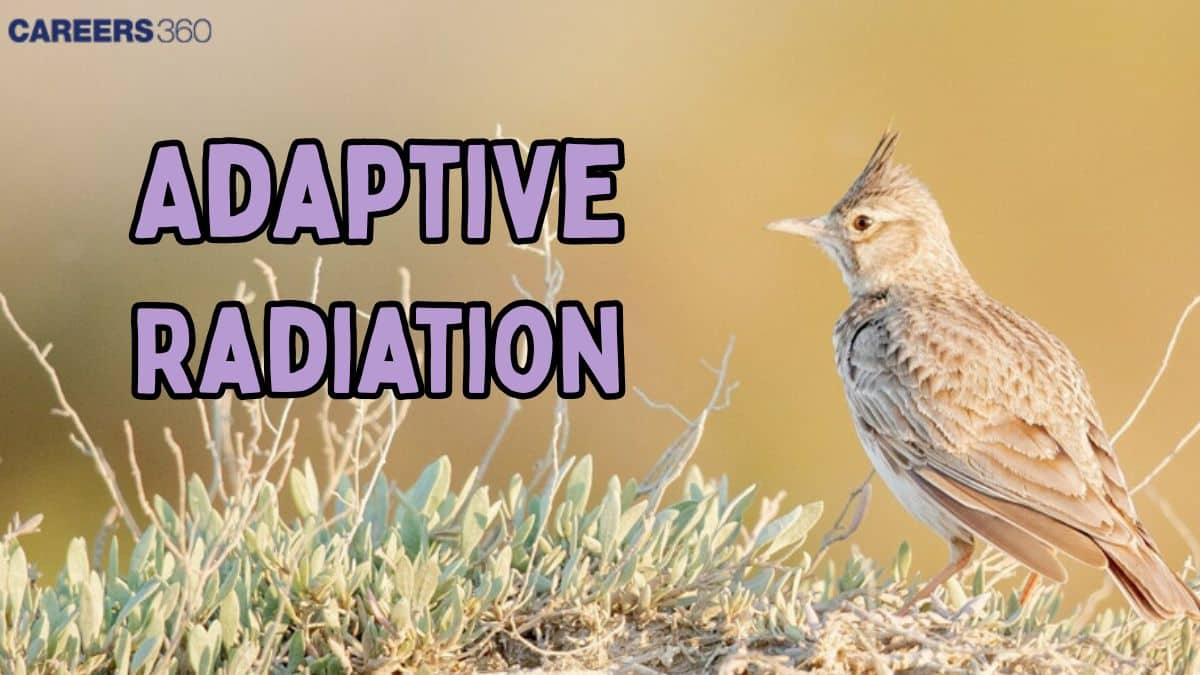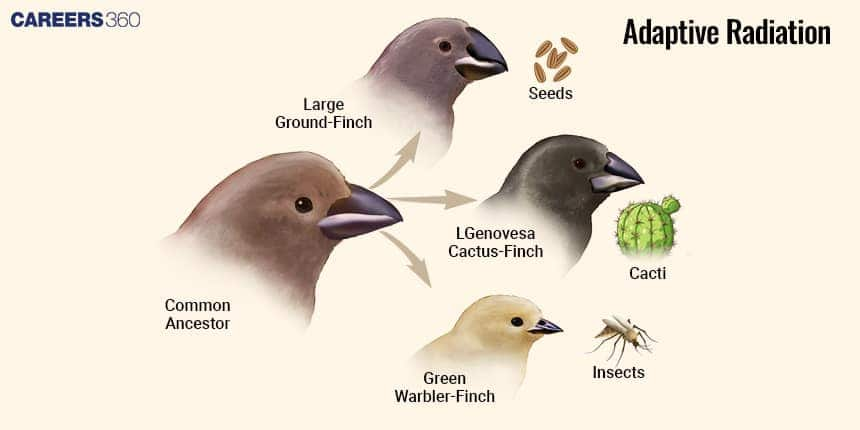Adaptive Radiation Evolution: Definition, Causes, Examples
Adaptive radiation is defined as the rapid diversification of a single ancestral species into multiple species. Each adapted to unique environments. Adaptive radiation in evolution helps species adapt to new habitats. This process starts from a common ancestor. From this ancestor, many new species have evolved. It explains the process through which organisms evolve and have different traits to occupy specific ecological niches, like adaptive radiation in the beaks of birds. Adaptive radiation explains speciation and evolution through changes in different environments.
This Story also Contains
- What is Adaptive Radiation?
- Causes of Adaptive Radiation
- Steps involved in Adaptive Radiation
- Adaptive Radiation Examples
- Importance of Adaptive Radiation
- Recommended video on Adaptive Radiation
- MCQs on Adaptive Radiation

Adaptive radiation and evolution are deeply connected. It shows how species fill empty habitats. Natural selection in adaptive radiation causes changes in traits. This process creates new species through evolution.Adaptive radiation in biology explains speciation. In this article, adaptive radiation, causes of adaptive radiation, and adaptive radiation examples are discussed. Species develop different feeding or mating strategies. They evolve due to environmental pressure. These changes support survival and reproduction.
What is Adaptive Radiation?
Adaptive radiation refers to the evolution of several species that originated from a common ancestral source, in which each new species will be adapted to a different environment or resource. Adaptive radiation is essentially a process of producing different species from one lineage, which is essential to answering how biodiversity first arises.
Adaptive radiation shows how one species can give rise to many. Each new species develops special traits. These traits help them live better in their new surroundings. This process increases the number of species on Earth. It explains how life becomes more diverse over time. Evolution by stages can be seen clearly in this process, as species gradually adapt to different niches. Changes in environment and availability of new resources help drive this process.
Causes of Adaptive Radiation
Adaptive radiation happens due to many reasons. It allows one species to form many. Over time, new species form. Each one fits a different niche. This process increases life diversity. Adaptive radiation shows how evolution works in nature. These changes are linked to evolution and the environment. Some of them are discussed below.
Change in environment or climatic conditions
Due to the arrival of a new predator in the place where the species is living
When there is no availability of food
Due to migration
Increase of new ecological opportunity
Due to the changes in genetic characteristics
Due to mutation pressure, natural selection, genetic drift, artificial selection, etc.
Steps involved in Adaptive Radiation
Adaptive radiation follows a clear process. It starts from one ancestor and results in many new species. Each step helps life adapt and diversify.
Common Ancestor is Present: All new species come from a single original ancestor.
New Environments or Opportunities: Arise Changes in environment or migration open up new ecological spaces.
Variation and Genetic Mutations: Occur Genetic changes and mutations create differences in traits.
Natural Selection Favors Beneficial Traits: Traits that help in survival get passed on more often.
New Species Evolve and Fill Niches: Different species adapt to different adaptations and habitats.
Adaptive Radiation Examples
Notable examples of adaptive radiation are those of Galápagos finches, Hawaiian honeycreepers, cichlid fishes in the African Great Lakes, and Anolis lizards in the Caribbean.
Adaptive Radiation in Beaks of Birds
A great example of adaptive radiation is the Galápagos or Darwin finches. The species evolved from a common ancestor but developed many different beak shapes and sizes to eat seeds, insects, and nectar. In this way, they evolved to fill many ecological niches on the islands. The diagram below shows the adaptation for better survival:

Hawaiian Honeycreepers
Hawaiian honeycreepers evolved to over 50 species from one ancestral species. These birds evolved different beak forms and sizes from the model itself, adapted to live life as insects, nectar, or seed feeders.
Cichlid Fishes of African Great Lake Areas
Cichlid fishes of the African Great Lakes have undergone large amounts of adaptive radiation. Hundreds of cichlid species have since then been adapted into different feeding strategies, habitats, and behaviours.
Anolis Lizards in The Caribbean
Anolis in the Caribbean have diversified into numerous species, each adapted to its ecological niche, such as a habitat on tree trunks, branches, or grasses. This gives rise to this adaptive radiation with a wide range of morphological and behavioural traits.
Importance of Adaptive Radiation
Adaptive radiation plays a major role in evolution. It explains how one ancestor gives rise to many new species. These species adapt to different environments and survive in various ecological niches. Adaptive radiation helps increase biodiversity and explains the origin of different life forms.
Increases biodiversity- It creates many new species and adds variety to life.
Drives the evolution of species- It helps species slowly change and become better adapted.
Supports Darwin Theory of Natural Selection- Only the best-adapted species survive and grow.
Fills ecological niches- Different species live in different places and use different resources.
Explains speciation- It shows how one species splits into many new ones.
Helps adaptation and survival- New species develop special features to live better in their environment.
Occurs after environmental change- When the environment changes, species also change to survive.
Shows role of mutation and variation- Small genetic changes lead to new features and new species.
Results from common ancestor- All new species come from one original ancestor.
Promotes diverse life forms- It explains why there are so many different kinds of animals and plants.
Recommended video on Adaptive Radiation
MCQs on Adaptive Radiation
Question: Directions: In the following questions, a statement of Assertion (A) is followed by a statement of reason (R).
Assertion – Darwin observed many varieties of finches on Galapagos Island.
Reasons – The evolution of insectivorous finches from original seed-eating finches is convergent.
Mark the correct choice as:
If both assertion and reason are true and reason is correct explanation of assertion.
If both assertion and reason are true but the reason is not the correct explanation of the assertion.
If the assertion is true but the reason is false.
If both assertion and reason are false.
Answer: Given that Darwin observed a wide variety of finches in the Galápagos Islands, Assertion (A) is accurate. He developed his theory of evolution with the aid of these finches.
The evolution of insect-eating finches from seed-eating finches is an example of divergent evolution, which is when species change over time rather than convergent evolution, which is when species become similar. For this reason, reason (R) is incorrect.
Hence, the correct answer is option 3)If the assertion is true but the reason is false.
Question: Among the following statements, which accurately describes an aspect of Darwin's theory of evolution?
Species undergo rapid and immediate changes resulting in the emergence of new species.
Acquired characteristics acquired during an individual's lifetime are invariably inherited by future generations.
The evolution of species is solely determined by random chance.
Darwin's theories have been universally rejected by the scientific community.
Answer: According to Darwin's theory, species undergo gradual changes over long periods, which can lead to the emergence of new species. This process is known as speciation and occurs through mechanisms such as natural selection, genetic variation, and adaptation. Darwin proposed that these changes accumulate gradually through the accumulation of small, advantageous variations over generations, rather than through rapid and immediate changes. This concept is a fundamental principle of Darwin's theory of evolution and is widely accepted in the scientific community.
Hence, the correct answer is option 1)Species undergo rapid and immediate changes resulting in the emergence of new species.
Question: Adaptive Radiation does not confirm ____________.
Homology
Evolution of new forms
Divergent Evolution
Convergent Evolution
Answer: Option 4) is correct because adaptive radiation does not confirm convergent evolution. Adaptive convergence is the one that confirms convergent evolution. The options such as homology, evolution of new forms, and divergent evolution are all applicable to adaptive radiation. Adaptive radiation is the process that gave rise to a variety of Australian marsupials. They consist of a large number of homologous organs.
Option 1) is incorrect because adaptive radiation confirms homology as the organisms which arise through adaptive radiation exhibit a large number of homologous organs.
Option 2) is incorrect because adaptive radiation confirms the evolution of new forms as adaptive radiation is a process in which organisms get diversified from ancestral species to many new forms.
Option 3) is also wrong because adaptive radiation confirms divergent evolution as the organisms which arise through adaptive radiation have great variations in their morphological and ecological characteristics.
Hence, the correct option is 4) Adaptive Radiation does not confirm Convergent Evolution.
Read More:
Frequently Asked Questions (FAQs)
Adaptive radiation occurs when a single or few founders become the ancestors of a diverse assortment of species, each novel in form and occupying a different ecological niche. The importance comes from driving biodiversity and the evolution of specialized traits.
Examples are the Galápagos finches, the Hawaiian honeycreepers, the cichlid fishes of African Great Lakes, and the Anolis lizards of the Caribbean.
Adaptive radiation enhances the biodiversity of living things, rearing a flock of species each to different environmental and niche conditions. It enriches habitats of various life forms.
The stages are colonisation, diversification, specialisation, and stabilisation. Mechanisms include speciation, natural selection, ecological niches, genetic variation, and reproductive isolation.
Darwin's finches diversified from a common ancestor into many species with differently shaped and sized beaks. This helped them adapt to different food sources and different ecological niches between the islands of Galápagos.